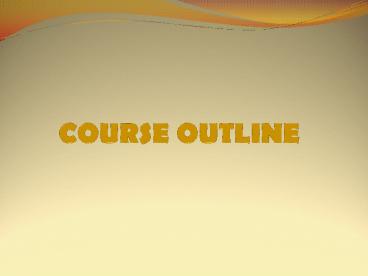COURSE OUTLINE - PowerPoint PPT Presentation
1 / 15
Title:
COURSE OUTLINE
Description:
Definition and Scope. Usul al-Fiqh defined as the science of the sources and methodology of the law according to the Quran and Sunnah. Methodology of usul al-fiqh ... – PowerPoint PPT presentation
Number of Views:159
Avg rating:3.0/5.0
Title: COURSE OUTLINE
1
COURSE OUTLINE
2
- Introduction to Usul al-Fiqh
- Quran...The first source
- Sunnah...The Qurans partner in legislation
- Rules of Interpretation I (Deduction)
- Rules of Interpretation II (Implications)
- Commands and Prohibitions
- Naskh (Abrogation)
- Ijma (Consensus)
3
Lesson One Introduction
- ToUsool-ul-Fiqh
4
Contents of the Lesson
- Definition and Scope
- Two Approaches to the Study of Usul al-Fiqh
- Proofs of Shariah (al-Adillah ash-Shariyyah)
5
Definition and Scope
- Usul al-Fiqh defined as the science of the
sources and methodology of the law according to
the Quran and Sunnah. - Methodology of usul al-fiqh refers to methods of
reasoning analogy (qiyas), juristic preference
(istihsan), presumption of continuity (istishab)
and the rules of interpretation and deduction. - Fiqh is the end product of usul al-fiqh yet, the
two are separate disciplines. - Fiqh is concerned with knowledge of detailed
rules of Islamic law (the law itself) usul
al-fiqh is concerned with methods applied in the
deduction of rules from their sources (the
methodology of the law).
6
- History of usul al-fiqh al-Shafeee coined as
the founder of usul al-fiqh from his book
ar-Risalah, most notably. - Difference between usul al-fiqh and the maxims of
fiqh (al-qawaid al-fiqhiyyah) the maxims of
fiqh refer to a body of abstract rules,
theoretical guidelines in the areas of fiqh such
as evidence, transactions, matrimonial, etc. As
such, they are an integral part of fiqh and
separate from usul al-fiqh. - Definition of asl as proof, root, origin, source,
and foundation, rules, principles on which a
branch of knowledge may be founded usul al-fiqh
means the roots of fiqh (its underlying evidence).
7
- Objective of usul al-fiqh is to regulate ijtihad
and guide the jurist in deducing the law from its
sources. - Usul al-fiqh regulates the application of qiyas,
istihsan, istishab, istislah, etc. which aids the
jurist in distinguishing which method of
deduction is best suited for obtaining a Sharia
compliant ruling to a particular problem.
8
Two Appoaches to the Study of Usul al-Fiqh
9
- The ulama of various schools adopted two
different approaches to the study of usul
al-fiqh, theoretical and deductive. - The theoretical approach is concerned with
exposition of theoretical doctrines tends to
envision usul al-fiqh as an independent
discipline to which fiqh must conform. (Mainly
the approach adopted by the Shafeee school, the
Mutakallimun, and the Mutazilah - The deductive approach formulates the theory in
the light of its application to relevant issues
attempts to relate usul al-fiqh more closely to
the detailed issues of furu al-fiqh. (Mainly
adopted by the Hanafi school.)
10
- When the Hanafis find a principle of usul to be
in conflict with an established principle of
fiqh, they are inclined to adjust the theory to
the extent that the conflict in question is
removed, or they try to make the necessary
exception in order to reach a compromise. - Adillah shariyyah and ahkam (the laws /values
that regulate the conduct of the mukallaf) are
the two principle themes of usul al-fiqh. - Adillah shariyyah refer to four principal proofs
or sources of the Shariah the Quran, Sunnah,
consensus, and analogy.
11
Proofs of Shariah (al-Adillah ash-Shariyyah)
12
- The proofs of Shariah have been divided into
transmitted proofs (adillah naqliyyah) and
rational proofs (adillah aqliyyah). Two other
transmitted proofs include the rulings of the
Companions and the laws revealed prior to the
advent of Islam (sharia man qablana). - Rationality alone is not an independent proof in
Islam, which is why the rational proofs cannot be
totally separated from the transmitted proofs. - Adillah shariyyah have been further classified
into mustaqillah and muqayyadah, that is,
independent and dependent proofs respectively.
13
- Each of the first three sources of the Sharia is
an independent asl, or dalil mustaqil, that is, a
proof in its own right. - Another classification of adillah is their
division into definitive (qati) amd speculative
(zanni) proofs. This division takes into
consideration of the proofs of Shariah not only
their entirety but also the detailed rules which
they contain.In this way, the Quran, Sunnah, and
ijma are definitive proofs in the sense that they
are decisive and binding.
14
Proofs of Shariah (al-Adillah ash-Shariyyah)
- Adillah are classified into three categories
15
(No Transcript)

